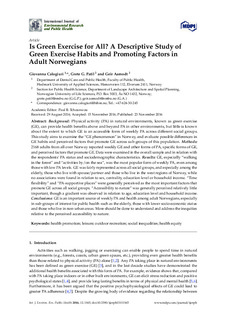| dc.description.abstract | Background: Physical activity (PA) in natural environments, known as green exercise (GE), can provide health benefits above and beyond PA in other environments, but little is known about the extent to which GE is an accessible form of weekly PA across different social groups. This study aims to examine the “GE phenomenon” in Norway, and evaluate possible differences in GE habits and perceived factors that promote GE across sub-groups of this population.
Methods: 2168 adults from all over Norway reported weekly GE and other forms of PA, specific forms of GE, and perceived factors that promote GE. Data were examined in the overall sample and in relation with the respondents’ PA status and sociodemographic characteristics.
Results: GE, especially “walking in the forest” and “activities by/on the sea”, was the most popular form of weekly PA, even among those with low PA levels. GE was fairly represented across all social groups, and especially among the elderly, those who live with spouse/partner and those who live in the west regions of Norway, while no associations were found in relation to sex, centrality, education level or household income. “Time flexibility” and “PA-supportive places” were generally perceived as the most important factors that promote GE across all social groups. “Accessibility to nature” was generally perceived relatively little important, though a gradient was observed in relation to age, education level and household income.
Conclusions: GE is an important source of weekly PA and health among adult Norwegians, especially in sub-groups of interest for public health such as the elderly, those with lower socio-economic status and those who live in non-urban areas. More should be done to understand and address the inequities relative to the perceived accessibility to nature. | nb_NO |

